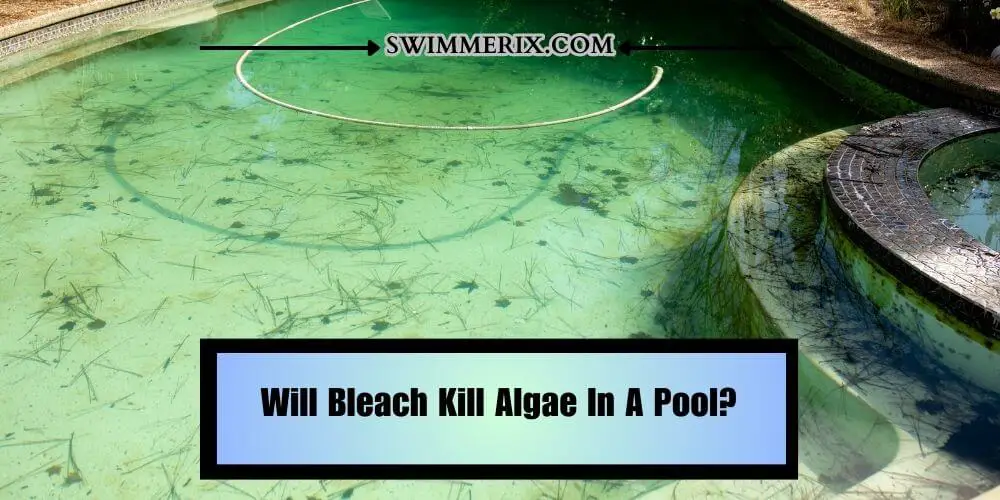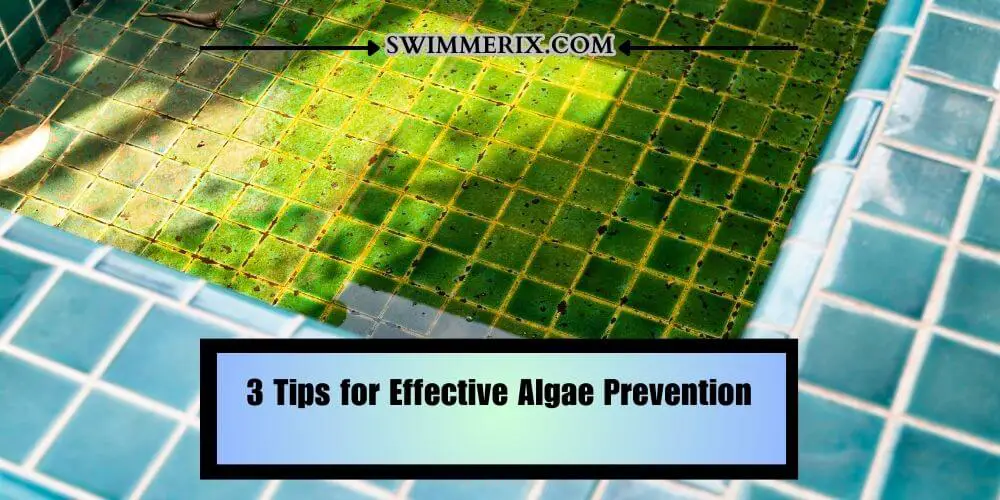
Regarding maintaining a clean & healthy pool system, bleach is very handy due to its powerful disinfectant properties known for killing bacteria, viruses & fungi. But is it effective against algae?
Algae tend to be one of the most common problems faced by many pool owners & finding & an effective solution is very important. Therefore, you might wonder, ‘Will bleach kill algae in a pool’ Read this post thoroughly.
In this article, I will help you explore the effectiveness of bleach as an algaecide, along with some step-by-step instructions on using bleach to eliminate algae growth in your Pool. Later on, I will also provide valuable tips to prevent future algae growth.
Algae are single-cell organisms that can thrive in warm & stagnant water. Also, they come in various forms, including green, yellow,& brown algae in pool. These unwanted invaders are known to quickly take over a pool, turning the water green, causing a slimy surface, and posing potential health risks.
Therefore, if you want to eliminate the algae from your Pool, I mention tips on using bleach as an algaecide below. However, before I tell you how to use bleach to remove algae, let’s first understand the answer: will bleach kill algae in a pool?
Also Read: Why Pool Sand Filter Not Filtering Algae?
Will Bleach Kill Algae In A Pool?

Yes, bleach can effectively kill algae in a pool. Bleach contains chlorine, which is a powerful disinfectant & sanitizer. When added to a pool, bleach raises the chlorine levels, creating an environment that is hostile to algae growth.
However, you should note that bleach will only kill the algae from a pool, but you must consider adding sanitizer to prevent it from entering your Pool again. You should know that there can be several factors contributing to the growth of algae.
First, sunlight provides the necessary energy for algae to multiply rapidly. This is why I highly recommend investing & installing a pool cover to protect the water from sunlight which not only keeps the algae at bay but also helps protect the chlorine from degradation due to sunlight.
Also, you should know that warmer temperatures accelerate algae growth, making the summer month particularly infested. Therefore, ensure that you pay attention to adequate water parameters & temperature during the summer months to prevent algae infestation.
You must provide proper chlorination, pH balance, and adequate circulation to prevent algae growth. You should know that approximately 90% of pool owners encounter algae once in their lifetime at some point, emphasizing the widespread nature of this issue.
Talking about bleach, it is considered to be very effective as algaecides as well. A study published in the Clorox found that bleach can effectively kill green algae, achieving A 95-95% reduction in algae cell count within 24 hours of treatment.
Therefore, using a beach as an algaecide can help you eliminate the algae from your Pool and get additional advantages. First & foremost, bleach is easily available in most households, which makes it convenient for immediate treatment.
Also, you might already know that bleach is a cost-effective solution compared to commercial algaecides due to bleach’ broad availability, making it a popular choice among po owners. Therefore, if you want to know how to use bleach effectively to kill algae in your Pool, let’s dive into it.
Using Bleach to Kill Algae in a Pool
Preparing The Pool For Treatment
Before you apply thebleachblis directly, you must prepare your Pool with salt treatment. Therefore, you must start by testing & balancing the pool water chemistry. Therefore, make sure to take the help of a reliable pool water testing kit to measure your pool water’s pH & alkalinity level accurately.
Ideally, the pH level should be maintained between 7.2-7.8 with a total alkalinity of around 80-120 parts per million. Also, remove any debris from the Pool and ensure proper circulation.
Algae growth tends to be more prevalent in areas with less water circulation. Therefore, ensure you are running the pool pump & clean the filter regularly to enhance circulation and filtration. As I told you earlier, algae also thrive in stagnant water. Therefore, proper circulation will ensure they don’t get a chance to thrive effectively in the Pool.
Calculating The Required Amount Of Bleach
It’s time to determine the appropriate amount of bleach to be used on the Pool & kill the algae. It would help if you first considered the recommended bleach concentration for algae treatment & the pool volume.
Generally, it is advised to have a bleach concentration of 10% to 12% for effective algae eradication. Below is a quick formula that can help you calculate the amount of bleach you need to kill algae in your Pool.
Use the following formula to calculate the amount of bleach needed:
Amount of Bleach (in gallons) = Pool Volume (in gallons) × Required Bleach Concentration (%)
For example, if you have a 20,000-gallon pool & want to use a 10% bleach solution, the calculation would be:
Amount of Bleach = 20,000 gallons × 0.10 = 2,000 gallons
Applying bleach to kill algae
After determining the appropriate amount of bleach you can use in your Pool to kill algae, you must first ensure the safety precautions. Therefore, make sure you prioritize your safety by wearing protective gloves, goggles, and clothes that can minimize direct contact with bleach.
I will also advise you to work in a well-ventilated area to avoid inhaling fumes. When applying bleach, distribute it evenly by pouring it gradually around the perimeter of your Pool while walking around.
This will not only ensure the bleach is well mixed but also it reaches all the areas of your Pool. You shouldn’t enter your Pool because the water will be temporarily cloudy after applying bleach. Well, this is usually a normal reaction & will clear up within a few hours.
Monitoring & Re-treatment
After you have treated your Pool with bleach, make sure you also monitor the chlorine level & pH level using a reliable testing kit regularly. To ensure effective algae eradication, maintain the chlorine level between 1.0-3.0 PPM.
However, additional treatment may be necessary if the chlorine level drops below the recommended range. If the algae infestation is very severe, I will advise you to repeat the process after 24-48 hours as necessary.
Also, make sure that you are maintaining the pool condition & bleach only if signs of algae regrowth appear. To know more about what you can do to prevent it and effectively kill the algae, I’m mentioning a couple of tips below.
Also Read: What To Do With Too Much Algaecide in Pool
3 Tips for Effective Algae Prevention

As you know, prevention is always better than cure, below I’m mentioning some practical tips that can help you keep your pool algae-free.
Maintain Proper Pool Water Chemistry
Ensure you are testing the water regularly to adjust the pH alkalinity and sanitizer level accordingly. Also, ensure that you perform shock treatment for your Pool periodically to eliminate any hidden algae or contaminants that might be inhibiting corners or steps of your Pool.
Ensure Proper Pool Circulation & Filtration
If you ensure proper pool circulation & preparation, you will keep the algae growth at bay from your Pool. Therefore, ensure you run the pool pump & filtration for adequate duration each day.
Also, it is important that you pay attention to cleanliness & maintaining the filtration system regularly to prevent any debris or contaminants buildup, which may provide nutrients for algae growth.
Limit sunlight exposure & debris accumulation.
As I mentioned in the above section, you should consider investing in a good quality pool cover or installing a shed structure for your Pool to reduce sunlight because algae are known to thrive in sunlight.
Providing a pool cover will prevent algae growth and protect against water loss & chlorine degradation by exposure to sunlight. Ensure you regularly remove leaves, twigs, & other organic matter from the Pool to minimize any nutrient availability for algae growth.
Conclusion
If you want to kill algae in your Pool, bleach is definitely an effective solution. Due to disinfectant properties, bleach is a versatile option for maintaining a clean & algae-free swimming environment.
If you follow all the steps outlined above for using bleach and implement preventive measures, you will be able to enjoy the crystal clear for a safe swimming session. Also, you must monitor the pool condition regularly & take appropriate action to prevent algae growth.
With proper care & maintenance, you can ensure a healthy inviting pool for you & your family and a visually appealing oasis to enjoy all summer long. I’ve given my best to give you an appropriate answer to the question, ‘Will bleach kill algae in a pool.’
If you find this article helpful, consider sharing it. Your share will help many people learn about the appropriate usage of bleach in swimming pools to kill algae and what other things they need to consider before applying bleach. Do check my other helpful guide on pool care & maintenance. See you in the next post, till then, take care & goodbye.

